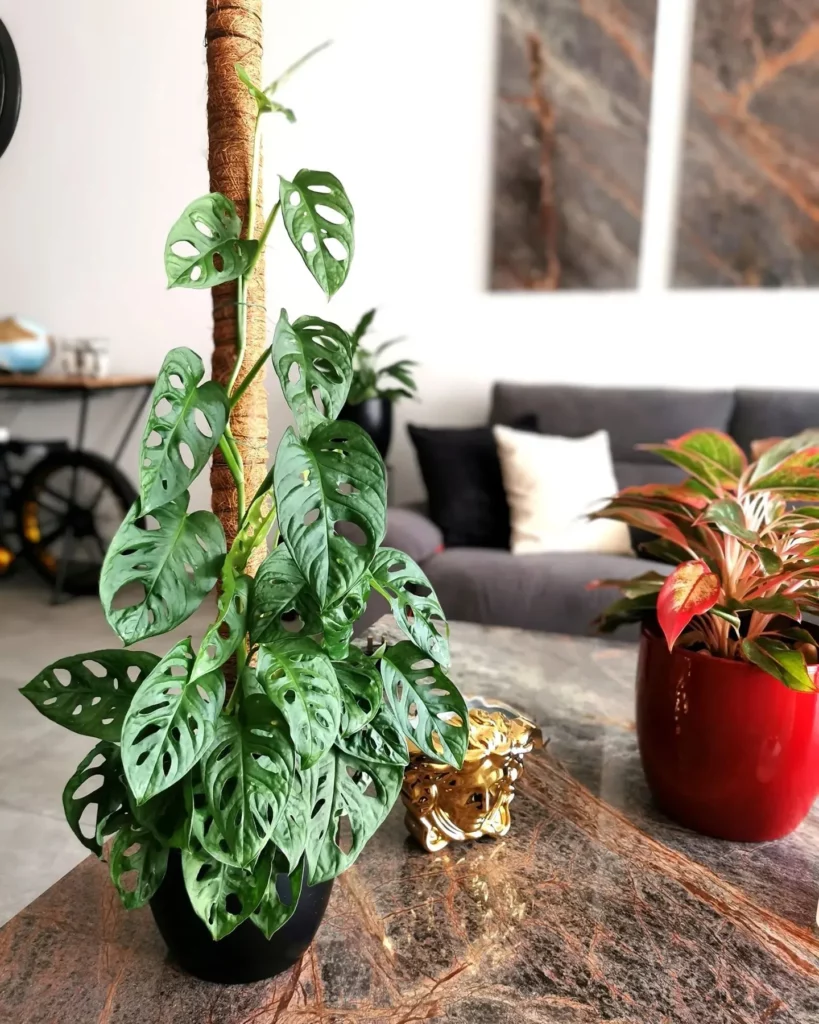Welcome to my Monstera Care Guide! If you’re a proud owner of a Swiss Cheese Plant, also known as Monstera adansonii, you’ve come to the right place. This tropical beauty is native to Central and South America and is known for its striking, hole-filled leaves that resemble Swiss cheese.
Key Takeaways:
- Proper care is essential for the thriving of your Monstera adansonii, also known as the Swiss Cheese Plant.
- Indoor plant care, specifically for tropical plants like Monstera adansonii, requires attention to lighting, watering, and humidity.
- Regular maintenance, pruning, and propagation are important aspects of caring for your Swiss Cheese Plant.
- Through proper care and attention, you can enjoy the beauty and charm of your Monstera adansonii in your indoor space.
About the Swiss Cheese Plant



The Swiss cheese plant, scientifically known as Monstera adansonii, is a popular indoor plant with large, heart-shaped leaves. It is a tropical perennial that is typically grown as a houseplant. The plant gets its name from the holes that develop in its leaves as it matures. Swiss cheese plants are fast growers and have a vining habit. They are commonly grown from young nursery plants and can be potted at any time. It’s important to note that all parts of the Monstera plant are toxic to pets.
Varieties of Swiss Cheese Plants
- Monstera deliciosa: The most well-known variety with larger leaves than Monstera adansonii.
- Monstera obliqua: Has thinner leaves with more holes compared to other varieties.
- Monstera dubia: A variegated cultivar with unique foliage patterns.
- Monstera siltepecana: Features lance-shaped leaves with silvery variegation.
- Monstera standleayana: Also known as ‘Albo Variegata,’ it has dark green and creamy white variegated leaves.
With its striking appearance and easy care requirements, the Swiss cheese plant is a favorite choice among indoor plant enthusiasts. Whether you opt for the classic Monstera adansonii or one of its unique varieties, these houseplants will bring a tropical touch to your home.
No products found.
Basic Care Requirements



When it comes to caring for your Swiss cheese plant, there are a few key things to keep in mind. Follow these care tips to ensure your plant thrives:
- Watering: The Swiss cheese plant likes to be consistently moist but not soaked. Check the soil by sticking your finger about an inch deep before watering. Water the plant when the soil feels nearly dry. Use a well-draining soil mix and make sure the pot has drainage holes.
- Light: This plant prefers bright, indirect sunlight. Direct sunlight can burn the leaves, so if it’s unavoidable, limit exposure to just two to three hours of morning sun. If possible, place the plant in a warm, well-lit bathroom.
- Humidity: The Swiss cheese plant thrives in high humidity. If your home is dry, increase humidity by misting the plant or using a humidifier.
- Fertilizing: Feed your plant monthly during the growing season with a balanced fertilizer made for houseplants. Look for a fertilizer with an N-P-K ratio of 5-2-3. Avoid fertilizing a newly potted plant for at least four to six months.
- Pruning: Pruning may be necessary to maintain the desired size and shape of your Swiss cheese plant. Use sterile pruning shears to cut back stems by no more than 25 percent. Remove any dead or damaged leaves as needed.
Other Tips:
- Use a peat-based potting mix to ensure proper moisture retention.
- Water until some excess water runs out of the drainage holes.
- Regularly dust the leaves to keep them clean and free from dust.
- Provide support for the plant with a stake if needed.
Light and Temperature Requirements



Proper lighting and temperature are crucial for the health and well-being of your Swiss cheese plant. By providing the right conditions, you can help your plant thrive indoors.
Plant Light Requirements
Swiss cheese plants prefer bright, indirect light. They are naturally found growing under the canopy of large trees in the jungle, so direct sunlight can burn their delicate leaves. If your plant is exposed to direct sunlight, limit the exposure to just two to three hours in the morning. Ideally, place your plant in a well-lit area with filtered or indirect sunlight.
Plant Temperature Requirements
Swiss cheese plants thrive in temperatures above 40 degrees Fahrenheit (4 degrees Celsius). They prefer warm environments with moderate humidity. A suitable temperature range for these plants is between 65 to 85 degrees Fahrenheit (18 to 29 degrees Celsius). Avoid exposing them to cold drafts or extreme temperature fluctuations, as it can stress the plant and affect its growth.
- Provide bright, indirect light for your Swiss cheese plant.
- Avoid exposing the plant to direct sunlight as it can burn the leaves.
- Maintain a temperature range of 65 to 85 degrees Fahrenheit.
- Avoid cold drafts and extreme temperature fluctuations.
Watering and Soil Requirements



Proper watering and soil conditions are essential for the health and growth of your Swiss cheese plant. Here are some tips to ensure you meet the watering and soil requirements of your indoor plant:
- Check the soil: Before watering your Swiss cheese plant, always check the moisture level of the soil. Stick your finger about an inch deep into the soil; if it feels nearly dry, it’s time to water.
- Consistent moisture: Swiss cheese plants prefer consistently moist soil, but be cautious not to overwater. It’s important to find a balance and avoid allowing the plant to sit in waterlogged soil. Choose a well-draining soil mix and ensure that the pot has drainage holes.
- Peat-based potting mix: It’s recommended to use a peat-based potting mix for your Swiss cheese plant. This type of mix retains moisture without causing waterlogging, ensuring the roots have access to the right amount of water.
- Watering technique: When watering, aim to thoroughly moisten the soil until some excess water runs out of the drainage holes. This helps ensure proper hydration without excess moisture, which can lead to root rot.
Fertilizing and Propagation



Fertilizing your Swiss cheese plant is an essential part of its care routine. By providing the right nutrients, you can promote healthy growth and vibrant foliage. Here are some tips for fertilizing your plant:
- Use a balanced fertilizer with an N-P-K ratio of 5-2-3. This will ensure that your plant gets the right amount of nitrogen, phosphorus, and potassium.
- Wait at least four to six months after potting a new plant before fertilizing it. The potting mix may already have slow-release fertilizer that can provide nutrients.
- Fertilize your Swiss cheese plant every month during the growing season, which is typically spring and summer. Dilute the all-purpose liquid fertilizer according to the manufacturer’s instructions.
In addition to fertilizing, you can also propagate your Swiss cheese plant to create new plants. Here are two common methods of propagation:
- Stem cuttings: Take a healthy stem cutting from the mother plant, making sure it has at least one node. Place the cutting in moistened soilless potting mix and keep it in a warm, humid environment. Roots should start to develop within a few weeks.
- Air layering: Select a healthy stem on the plant and make a small incision. Wrap the incision with moist sphagnum moss and secure it with plastic wrap. Roots will form within a few weeks. Once the roots are well-developed, you can cut the stem below the roots and pot it as a new plant.
Pruning and Maintenance



Keeping up with the pruning and maintenance of your Swiss cheese plant is essential for its overall health and appearance. Regular pruning helps control the size and growth of the plant, while maintenance tasks ensure that it stays in top condition. Here are some tips to help you with plant pruning and indoor plant maintenance:
- Trimming the stems: Use sterile pruning shears to cut back the stems of your Swiss cheese plant. It’s best to trim no more than 25 percent of the stem’s length to avoid shocking the plant. This will help maintain its desired size and shape.
- Removing dead leaves: Regularly remove any dead or damaged leaves from your Swiss cheese plant. This not only improves its appearance but also prevents the spread of diseases and pests.
- Dusting the leaves: Dust can accumulate on the leaves of your Swiss cheese plant, affecting its ability to photosynthesize. Gently wipe the leaves with a soft cloth or sponge to keep them clean and free from dust.
- Providing support: As your Swiss cheese plant grows, it may need some support to keep it upright. Consider using a stake or trellis to provide support and guide its growth.
Maintaining the size:
Swiss cheese plants have the potential to grow quite tall in their natural habitat. As houseplants, they may grow 1 to 2 feet per year under optimal conditions. Regular pruning and maintenance help control the size of the plant so that it remains manageable in your indoor space.
Caring for larger plants:
If you have a large Swiss cheese plant that has outgrown its current pot, you may need to repot it into a larger container. Follow the potting and repotting guidelines to ensure the plant has enough space for its roots to grow.
Varieties of Swiss Cheese Plants



Swiss cheese plants come in a variety of species, each with its own unique characteristics. Here are some popular varieties:
1. Monstera deliciosa
Monstera deliciosa, also known as the Swiss cheese plant, is the most well-known variety. It features large, heart-shaped leaves with distinct holes and is a popular choice among indoor plant enthusiasts.
2. Monstera adansonii
Monstera adansonii, the true Swiss cheese plant, has smaller leaves compared to Monstera deliciosa but is just as charming. It also develops beautiful holes as it matures, making it a stunning addition to any indoor plant collection.
3. Monstera obliqua
Monstera obliqua is known for its incredibly thin leaves with even more pronounced holes. It is a rare variety and highly sought after by plant collectors due to its delicate and unique appearance.
4. Monstera dubia
Monstera dubia is a variegated cultivar of the Swiss cheese plant. Its leaves exhibit stunning patterns of creamy white variegation against the dark green foliage, adding an extra touch of elegance to any space.
5. Monstera siltepecana
Monstera siltepecana is characterized by its lance-shaped leaves with silvery variegation. This variety adds a touch of shimmer and texture to any indoor plant collection, making it a favorite among plant enthusiasts.
6. Monstera standleayana
Monstera standleayana, also known as ‘Albo Variegata,’ features leaves with dark green and creamy white variegation. The contrasting colors create a striking visual display, making it a highly desirable variety for collectors.
These are just a few of the many varieties of Swiss cheese plants available. Each variety offers its own unique beauty and charm, allowing you to find the perfect fit for your indoor plant collection.
Potting and Repotting



Proper potting and repotting are essential for the health and growth of your Swiss cheese plant. Here are some tips to help you with this process:
Choosing the Right Pot
When selecting a pot for your Swiss cheese plant, opt for one that has drainage holes to prevent waterlogging. Hanging baskets are also popular choices. Ensure that the pot is slightly larger than the root ball to allow room for growth.
Potting Mix
For potting your Swiss cheese plant, use a peat-based potting mix. This type of mix retains moisture while still providing proper drainage. It also helps to mimic the plant’s natural habitat. Avoid using regular garden soil as it can become compacted and hinder root growth.
Repotting Frequency
Repot your Swiss cheese plant every two years or when you notice the roots poking out of the drainage holes or soil line. Springtime is the best season for repotting. Remember not to disturb the root ball too much during the process to avoid causing unnecessary stress to the plant.
Common Pests and Diseases



Keeping your Swiss cheese plant healthy and vibrant requires being aware of common pests and diseases that can affect it. Here are some of the most common issues to watch out for:
Plant Pests
- Mealybugs: These small, white insects can be found on the leaves and stems, sucking sap from the plant. Use an insecticidal soap or neem oil to control them.
- Spider Mites: These tiny pests can cause leaves to turn yellow and develop webs. Regularly misting the plant can help prevent infestations.
- Scale: Scale insects appear as small, raised bumps on the plant’s leaves and stems. Remove them manually or use insecticidal soap.
- Whitefly: These tiny, white insects can cause leaves to turn yellow and drop prematurely. Use yellow sticky traps or insecticidal soap to control them.
Common Diseases
- Root Rot: Overwatering can lead to root rot, causing the plant’s roots to become mushy and black. Ensure the soil is well-drained and adjust your watering schedule accordingly.
- Rust: Rust-colored spots on the leaves may indicate a fungal infection. Remove infected leaves and treat with a fungicide if necessary.
- Powdery Mildew: This fungal infection appears as a white, powdery coating on the leaves. Improve air circulation and treat with a fungicide if needed.
- Blight: Blight causes dark, water-soaked spots on the leaves, stems, and fruit. Remove infected plant parts and treat with a fungicide to prevent further spread.
Vigilance and regular plant inspections can help you catch and address pest or disease issues early, ensuring the health and longevity of your Swiss cheese plant.
Troubleshooting Common Issues



As plant owners, we all encounter common issues from time to time, and it’s no different when it comes to caring for your Swiss cheese plant. Here are some troubleshooting tips for addressing common problems:
Yellowing Leaves:
If you notice your Monstera’s leaves turning yellow, it could be a sign of overwatering. Check the moisture level of the soil and adjust your watering routine accordingly. Allow the soil to dry out slightly between waterings to prevent waterlogged roots.
Curling Leaves:
Curling or wrinkled leaves may indicate that your Swiss cheese plant is experiencing dry soil. Ensure that you are providing enough water to keep the soil consistently moist. Consider misting the leaves or placing a tray of water nearby to increase humidity levels.
Leaves with Black Marks:
If you notice black marks on the leaves of your Monstera, it may be a result of leaf burn from direct sunlight. Move your plant to a location with bright, indirect light and avoid exposing it to prolonged periods of direct sunlight.
Drooping Leaves:
Drooping leaves or slow growth can be a sign of insufficient light exposure. Make sure your Swiss cheese plant is placed in a well-lit area, but away from direct sunlight. Consider supplementing with artificial grow lights if natural light is limited.
Conclusion
In conclusion, caring for your Swiss cheese plant, also known as Monstera adansonii, is a rewarding experience that can bring tropical beauty into your home. By following the tips and guidelines provided in this Monstera care guide, you can ensure the health and vitality of your indoor plant.
Remember to provide your Swiss cheese plant with bright, indirect sunlight, as direct sunlight can cause leaf burn. Keep the soil consistently moist but not soaked, and use a well-draining, peat-based potting mix. Fertilize monthly during the growing season with a balanced houseplant fertilizer, and prune the plant as needed to control its size and shape.
FAQ
Is the Swiss cheese plant toxic to pets?
Yes, all parts of the Swiss cheese plant are toxic to pets. Keep it out of reach of your furry friends.
How much light does the Swiss cheese plant need?
The Swiss cheese plant prefers bright, indirect sunlight. Avoid direct sunlight, as it can burn its leaves.
How often should I water my Swiss cheese plant?
Water the plant when the soil is nearly dry, typically once a week. Ensure the pot has drainage holes.
How do I fertilize a Swiss cheese plant?
Use a balanced fertilizer with an N-P-K ratio of 5-2-3. Fertilize monthly during the growing season at half the recommended strength.
How can I propagate a Swiss cheese plant?
You can propagate a Swiss cheese plant through stem cuttings or air layering. Cuttings can be planted in moistened soilless potting mix.
How often should I prune my Swiss cheese plant?
Pruning may be necessary to control the size and shape of the plant. Use sterile pruning shears and remove dead or damaged leaves as needed.
What are the different varieties of Swiss cheese plants?
There are several varieties, including Monstera deliciosa, Monstera obliqua, Monstera dubia, Monstera siltepecana, and Monstera standleayana.
When should I repot my Swiss cheese plant?
Repot the plant every two years or when the roots start poking out of the drainage holes or soil line. Spring is the best time for repotting.
How do I deal with pests and diseases on my Swiss cheese plant?
Common pests like mealybugs and spider mites can be treated with nontoxic insecticides or neem oil. Watch out for diseases like root rot and powdery mildew.
What should I do if my Swiss cheese plant’s leaves turn yellow?
Yellowing leaves may indicate overwatering. Adjust your watering schedule and ensure proper drainage.
Why are my Swiss cheese plant’s leaves curling?
Curling leaves may be a sign of dry soil. Ensure your plant is getting enough water and humidity.
How can I prevent and manage common issues with my Swiss cheese plant?
Regular maintenance, such as dusting the leaves and providing support with a stake, can help prevent and manage common issues. Keep an eye out for any changes in the plant’s appearance.




